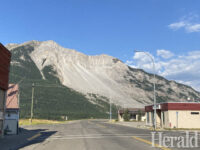Making school zones safer for students
By Jensen, Randy on September 16, 2020.
 With the start of school motorists are reminded that school zones are back into effect around the city. Herald file photo by Ian Martens
@IMartensHerald
With the start of school motorists are reminded that school zones are back into effect around the city. Herald file photo by Ian Martens
@IMartensHeraldMotorists have role to play
in protecting students
Laura Lukye
Alberta Health Services
School is back in, and this means school zones will be congested and busy. This year there will be more congestion and anxiety within the school zones, since more students are having to walk, bike or get a ride to school. With the increase in traffic comes a need for increased attention from parents and students when children are being dropped off and picked up. Motorists who are passing through school zones need to be extra vigilant, as well.
Every year in Canada, we see an average of:
– 30 child pedestrians killed;
– 20 child bicyclists killed;
– 2,400 child pedestrians injured; and
– 1,800 child bicyclists injured
– Parachute Canada
These statistics are all preventable. We need to make sure school zones are safe for all students, families and drivers. Traffic congestion and unsafe driver behaviour are very common in school zones and this leads to unsafe conditions that put everyone at risk.
Steps to take to make a school zone safe:
– Know and follow school zone rules – Know your schools specific drop-off and pick-up procedures. Talk to your school about the school zone safety plan;
– Focus on what you can control – Leave yourself plenty of time to get to the school to pick up or drop off, being late leads to higher anxiety and stress. Leslie Maxwell (School Travel Planner Supervisor, Waterloo) summed it up great saying drivers get “commuter brain” when in high-stress environment, this adds tension/stress in the cabin of the car and parents are quick to react without thinking and are not 100 per cent, leading to dangerous situations.
– Promote Active Transportation – only 25 per cent of children and youth age 5-17 use “active transportation” which is walking, cycling, skateboarding or scootering to school. Children that are capable to walk or ride to school are being dropped in a motor vehicle, instead. We need to promote active transportation; not only does it decrease congestion in school zones but increases students physical activity (Parachute,Canada); and
– Talk to your kids – make sure your kids are well informed about the safety procedures, to always use a crosswalk or marked crossing , never stand between two parked cars, don’t dart out in traffic and be aware at all times.
If you would like more information about school zone safety or even looking into making your school zone a safer place, visit Parachute Canada at http://www.parchute.ca; they have lots on information and a tool kit on how to get started with your school.
Laura Lukye is a Health Promotion Facilitator with AHS Population Health in the South Zone. She can be reached via e-mail: laura.lukye@ahs.ca
20-19




